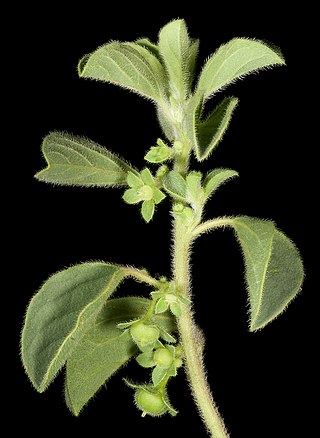
Phyllanthus is the largest genus in the plant family Phyllanthaceae. Estimates of the number of species in this genus vary widely, from 750 to 1200. Phyllanthus has a remarkable diversity of growth forms including annual and perennial herbs, shrubs, climbers, floating aquatics, and pachycaulous succulents. Some have flattened leaflike stems called cladodes. It has a wide variety of floral morphologies and chromosome numbers and has one of the widest range of pollen types of any seed plant genus.

Phyllanthaceae is a family of flowering plants in the eudicot order Malpighiales. It is most closely related to the family Picrodendraceae.

The family Pandaceae consists of three genera that were formerly recognized in the Euphorbiaceae. Those are:
Savia dictyocarpa is plant belonging to the family Phyllanthaceae, native to Brazil.

Bischofia is a genus of plants in the family Phyllanthaceae first described as a genus in 1827. It is native to southern China, the Indian Subcontinent, Queensland, New Guinea, and various islands of the Pacific. It is the only member of the tribe Bischofieae. They are dioecious, with male and female flowers on separate plants, but may rarely be monoecious.

Bridelieae is a tribe of the family Phyllanthaceae.

Phyllantheae is a tribe of the family Phyllanthaceae. The taxonomy of the group is not yet clear, and work continues. A recent revision based on nuclear and chloroplast DNA sequences divides the tribe into 6 subtribes and 18 genera.
Wielandieae is a tribe of the family Phyllanthaceae. It comprises 9 genera.
Thecacoris is a genus of flowering plant belonging to the family Phyllanthaceae first described as a genus in 1821. It is native to tropical Africa and Madagascar. It is dioecious, with male and female flowers on separate plants, although it may rarely be monoecious.
Protomegabaria is a genus of flowering plant belonging to the family Phyllanthaceae first described as a genus in 1911. It is native to western and central Africa. It is dioecious, with male and female flowers on separate plants.
- Protomegabaria macrophylla(Pax) Hutch. - Nigeria, Cameroon, Republic of the Congo, Gabon, Gulf of Guinea Islands
- Protomegabaria meiocarpaJ.Léonard - Gabon, Democratic Republic of the Congo
- Protomegabaria stapfiana(Beille) Hutch. - West Africa

Glochidion is a genus of flowering plants, of the family Phyllanthaceae, known as cheese trees or buttonwood in Australia, and leafflower trees in the scientific literature. It comprises about 300 species, distributed from Madagascar to the Pacific Islands. Glochidion species are used as food plants by the larvae of some Lepidoptera species including Aenetus eximia and Endoclita damor. The Nicobarese people have attested to the medicinal properties found in G. calocarpum, saying that its bark and seed are most effective in curing abdominal disorders associated with amoebiasis.

Phyllanthus mirabilis is a plant species of family Phyllanthaceae and is native to Thailand, Laos and Myanmar. It is one of the only four Phyllanthus to be caudiciform and the one of the only two caudiciform Phyllanthus to be described, with the other being Phyllanthus kaweesakii. The leaves fold together at night. Wild plants are found on limestone mountains and cliffs.

A pseudanthium is an inflorescence that resembles a flower. The word is sometimes used for other structures that are neither a true flower nor a true inflorescence. Examples of pseudanthia include flower heads, composite flowers, or capitula, which are special types of inflorescences in which anything from a small cluster to hundreds or sometimes thousands of flowers are grouped together to form a single flower-like structure. Pseudanthia take various forms. The real flowers are generally small and often greatly reduced, but the pseudanthium itself can sometimes be quite large.

Richeria grandis is a tree species in the family Phyllanthaceae which ranges from the Lesser Antilles to South America. The species is reputed to have aphrodisiac properties.

Euphorbiaceae, the spurge family, is a large family of flowering plants. In English, they are also commonly called euphorbias, which is also the name of the type genus of the family. Most spurges, such as Euphorbia paralias, are herbs, but some, especially in the tropics, are shrubs or trees, such as Hevea brasiliensis. Some, such as Euphorbia canariensis, are succulent and resemble cacti because of convergent evolution. This family has a cosmopolitan global distribution. The greatest diversity of species is in the tropics; however, the Euphorbiaceae also have many species in nontropical areas of all continents except Antarctica.
Poranthereae is a tribe in the plant family Phyllanthaceae. It is one of ten tribes in the family, and one of four tribes in the subfamily Phyllanthoideae. Poranthereae comprises about 111 species, distributed into eight genera. The largest genera and the number of species in each are Actephila (31), Meineckia (30), and Andrachne (22).

Notoleptopus is a monotypic genus of flowering plants in the family Phyllanthaceae. It is one of eight genera in the tribe Poranthereae. The sole species is Notoleptopus decaisnei. It is a monoecious shrub, native to Australia, New Guinea, and Indonesia.

Epicephala is a genus of moths in the family Gracillariidae.
Aporosa villosa is a species of shrub or small tree in the family Phyllanthaceae. It is found in Southeast Asia, including the Nicobar, Andaman and Paracel Islands. There are some traditional medicinal uses for plant, particularly around care after childbirth. The shrub is often a pioneer species, tolerant of full sun, but intolerant of frequent fires.

Phyllanthus fluitans, also known as the red root floater, floating spurge, or apple duckweed is a species of free floating aquatic plant and herbaceous perennial in the family Phyllanthaceae. This species is one of the only three non-terrestrial species in the genus Phyllanthus, with the other species being P. leonardianus and P. felicis. The generic name comes from Ancient Greek meaning leaf or a leaf flower, and the specific name comes from Latin meaning floating or float. It was described in March 1863 by George Bentham and Johannes Müller Argoviensis.













